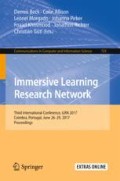Abstract
We live in an increasingly competitive world where success is closely linked to a person’s or organisation’s ability to innovate which, in turn, means that innovation has become increasingly important in education and business. One response to this has been the introduction of special environments, tailored to supporting innovation, namely Innovation-Labs (i-Labs). Research has shown that creativity thrives in environments that are playful and customizable, rather than in the somewhat sterile environments of most workplaces. In this paper, we describe our efforts to create a model for an online immersive environment that can be customized and dynamically adapted to the needs of individuals and specific innovation sessions. In creating this model we have been inspired by earlier pioneering work in innovation labs, virtual reality, HCI and the World Wide Web. This work-in-progress paper presents the output of our theoretical studies, and an initial specification for an immersive reality innovation space called iSuite. This environment is based on an underlying model that is made up of a number of innovative features which include a customisable template-based generic interfacing scheme which supports human-machine and machine-machine interactions and supporting systems to assist i-Lab users during brainstorming.
References
Forum, W.E.: The future of jobs: employment, skills and workforce strategy for the fourth industrial revolution (2016). http://www3.weforum.org/docs/WEF_Future_of_Jobs.pdf. Accessed 5 Jan 2017
Schwab, K.: The Fourth Industrial Revolution: what it means, how to respond (2016). https://www.weforum.org/agenda/2016/01/the-fourth-industrial-revolution-what-it-means-and-how-to-respond. Accessed 5 Jan 2017
Gill, G., Oldfield, S.: Scribbling on the Walls: Introducing Creativity at UEA, the Story So Far. Cardiff, Wales (2007)
Susnea, I., Pecheanu, E., Tudorie, C., Cocu, A.: The education for creativity–the only student’s tool for coping with the uncertainties of the future. In: MAC ETEL 2014–International Conference on Education, Teaching and e-Learning, Prague, October 2014
Powell, L.: The where factor: New Environments for Innovative Thinking, White paper https://www.facilitate.com/
Bentley, I.: Responsive Environments: A Manual for Designers. Routledge, London (1985)
Chin, J., Callaghan, V., Clarke, G.: A programming-by-example approach to customising digital homes (2008)
Sailer, K., Pomeroy, R., Haslem, R.: Data-driven design—using data on human behaviour and spatial configuration to inform better workplace design. Corp. Real Estate J. 4, 249–262 (2015)
Kemp, J., Livingstone, D.: Putting a second life “metaverse” skin on learning management systems. In: Proceedings of the Second Life Education Workshop at the Second Life Community Convention (2006)
Azhar, S., Khalfan, M., Maqsood, T.: Building information modelling (BIM): now and beyond. Constr. Econ. Build. 12, 15–28 (2015)
Callaghan, V., Davies, M., Zhang, S.: An online immersive reality innovation-lab. In: iLRN (2016)
Wu, H.-Y., Callaghan, V.: From imagination to innovation: a creative development process. In: iLRN (2016)
Lewis, M., Moultrie, J.: The organizational innovation laboratory. Creativity Innov. Manag. 14, 73–83 (2005)
Moultrie, J., Nilsson, M., Dissel, M., Haner, U.E., Janssen, S., Van der Lugt, R.: Innovation spaces: towards a framework for understanding the role of the physical environment in innovation. Creativity Innov. Manag. 16, 53–65 (2007)
Van Helvert, J., Fowler, C.: Scenario-based user needs analysis. In: Chimera Working Paper, vol. 2 (2003)
Chism, N.V.N.: Challenging traditional assumptions and rethinking learning spaces. In: Learning Spaces, pp. 2–7 (2006)
Perks, T., Orr, D., Al-Omari, E.: Classroom re-design to facilitate student learning: a case study of changes to a university classroom. J. Sch. Teach. Learn. 16, 53–68 (2016)
Whiteside, A., Fitzgerald, S.: Designing learning spaces for active learning. Implications 7, 1–6 (2009)
Acknowledgements
We are pleased to acknowledge the United Kingdom government for the provision of a PhD scholarship to the lead author who is a Commonwealth Scholar. We also wish to express our appreciation to Dr Marc Davies and the Creative Science Foundation for making their resources, and especially their ‘Spacestation’ VR platform, available to this project. In addition we wish to thank Dr Anasol Pena-Rios for her generosity in supplying the BReal platform code which we have used as the basis of the server technology. We are also indebted to Gurpreet Gill for providing background information about the foundational UEA work. Finally, we wish to express our gratitude to Ella Green for granting us access to, and information on, the University of Essex i-Lab.
Author information
Authors and Affiliations
Corresponding author
Editor information
Editors and Affiliations
Rights and permissions
Copyright information
© 2017 Springer International Publishing AG
About this paper
Cite this paper
Salako, O., Gardner, M., Callaghan, V. (2017). Towards Online Immersive Collaborative Innovation Spaces. In: Beck, D., et al. Immersive Learning Research Network. iLRN 2017. Communications in Computer and Information Science, vol 725. Springer, Cham. https://doi.org/10.1007/978-3-319-60633-0_1
Download citation
DOI: https://doi.org/10.1007/978-3-319-60633-0_1
Published:
Publisher Name: Springer, Cham
Print ISBN: 978-3-319-60632-3
Online ISBN: 978-3-319-60633-0
eBook Packages: Computer ScienceComputer Science (R0)

